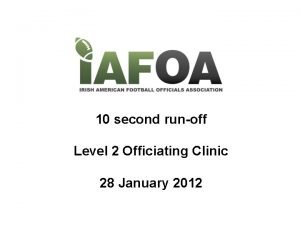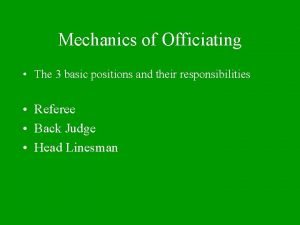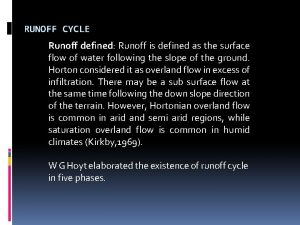10 second runoff Level 2 Officiating Clinic 28



- Slides: 3

10 second run-off Level 2 Officiating Clinic 28 January 2012

Rule 3 -4 -4 • • • ARTICLE 4. a. With the game clock running and less than one minute remaining in either half, if a player of either team commits a foul that causes the clock to stop, the officials may subtract 10 seconds from the game clock at the option of the offended team. The fouls that fall in this category include but are not limited to: 1. Any foul that prevents the snap (e. g. , false start, encroachment, defensive offside by contact in the neutral zone, etc. ); 2. Intentional grounding to stop the clock; 3. Incomplete illegal forward pass; 4. Backward pass thrown out of bounds to stop the clock; 5. Any other foul committed with the intent of stopping the clock. – – The offended team may accept the yardage penalty and decline the 10 -second subtraction. If the yardage penalty is declined the 10 -second subtraction is declined by rule. b. The 10 -second rule does not apply if the game clock is not running when the foul occurs or if the foul does not cause the game clock to stop (e. g. , illegal formation). c. After the penalty is administered, if there is a 10 -second subtraction, the game clock starts on the referee’s signal. If there is no 10 -second subtraction, the game clock starts on the snap. d. If the fouling team has a timeout remaining they may avoid the 10 -second subtraction by using a timeout. In this case the game clock starts on the snap after the timeout.

Rule 3 -4 -4 cont. • • • This new Article introduces a NFL-style 10 -second deduction penalty. It applies only in the last one minute of each half of the game. If the clock is running and there is a foul that has the effect of stopping the clock, for example a false start or defensive offside, the offended team has the choice of enforcing a 10 -second runoff in addition to the distance penalty. It does not apply if the clock was already stopped or if it stops for any other reason, for example a score or a first down. There a number of permutations as to what happens: They can decline the runoff and accept the distance alone but they may not take the runoff without the distance. If they do accept the runoff then the clock will always start on the ready. If they decline the runoff, then the clock will always start on the snap. If the penalty does not include the runoff, then there is no change to clock procedures (it starts on the snap or ready as before). The fouling team can trump the runoff by taking a timeout, though. If there is a mixture of fouls that include and exclude the runoff, the runoff only applies if the penalty to which it is attached is accepted. Offsetting fouls eliminate the runoff. Dead ball fouls by both teams, though, may include the runoff. Lastly, if there was less than 10 seconds remaining in the period and the runoff is enforced then the period is over. Any subsequent dead-ball fouls would then become interval fouls. If there is more football to play (either the second half or overtime), then those penalties would carry over. If the game is over, then the fouls are cancelled by rule.





